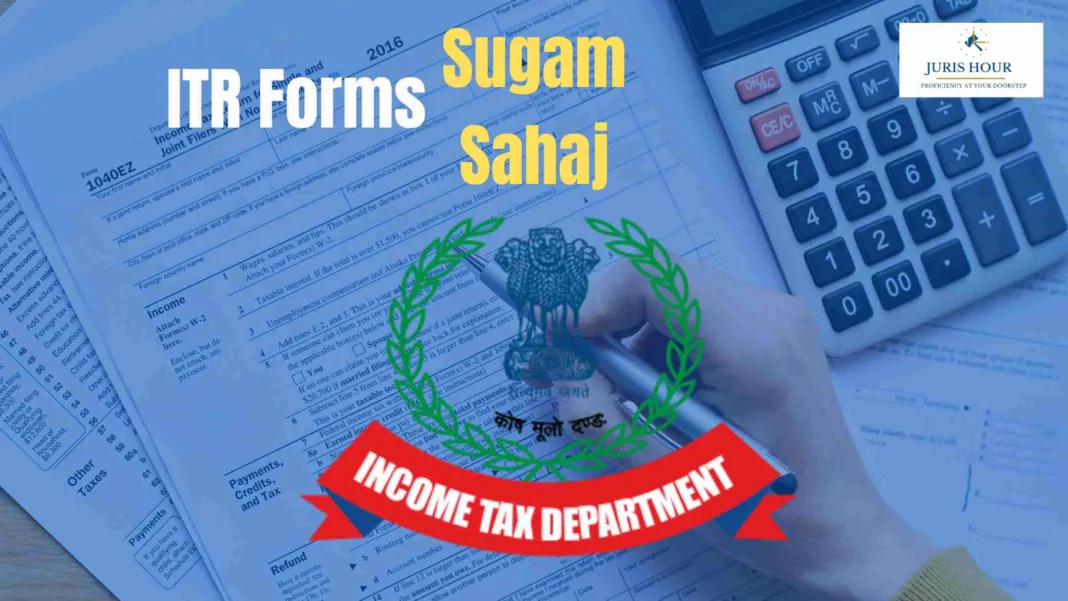As the deadline for filing Income Tax Returns (ITR) for Financial Year (FY) 2024–25 approaches, individual taxpayers and small businesses must familiarize themselves with the relevant ITR forms. The Income Tax Department of India offers simplified return filing through two key forms — Sahaj (ITR-1) and Sugam (ITR-4). These are specifically designed for ease of filing and cater to salaried individuals, pensioners, and small business owners.
This guide explores everything you need to know about Sahaj and Sugam forms, including eligibility, structure, filing process, and key differences, helping you make the right choice this tax season.
What is ITR-1 Sahaj?
ITR-1 Sahaj is a simplified one-page form for resident individuals with income up to ₹50 lakh from the following sources:
Eligibility for ITR-1 Sahaj
- Income from salary or pension
- Income from one house property
- Income from other sources (like interest from savings account, deposits, etc.)
- Agricultural income (up to ₹5,000)
Who Cannot Use ITR-1 Sahaj?
- Total income exceeding ₹50 lakh
- Income from more than one house property
- Income from lottery, racehorses, or legal gambling
- Individuals with capital gains
- Residents having foreign assets or foreign income
- Directors in a company or those holding unlisted equity shares
- Taxpayers with income from business or profession
What is ITR-4 Sugam?
ITR-4 Sugam is designed for individuals, Hindu Undivided Families (HUFs), and firms (other than LLPs) with presumptive income under sections 44AD, 44ADA, or 44AE.
Eligibility for ITR-4 Sugam
- Business income under Section 44AD (presumptive taxation scheme for small businesses)
- Professional income under Section 44ADA (for professions like doctors, architects, etc.)
- Income from goods carriage under Section 44AE
- Income up to ₹50 lakh (professionals) and ₹2 crore (businesses opting presumptive)
Who Cannot Use ITR-4 Sugam?
- Income from more than one house property
- Income from capital gains
- Income from speculative business or commission
- If you hold directorships or unlisted shares
- Foreign assets or signing authority in any account outside India
- Regular books of accounts are maintained
Key Differences Between ITR-1 Sahaj and ITR-4 Sugam
| Feature | ITR-1 Sahaj | ITR-4 Sugam |
| Applicable to | Salaried/pensioners | Small businesses/professionals |
| Presumptive income allowed | No | Sections 44AD/ADA/AE |
| Maximum Income Limit | ₹50 lakh | ₹50 lakh (professionals), ₹2 crore (business) |
| House Property | Only one allowed | One allowed |
| Foreign Assets/Income Allowed | No | No |
| Capital Gains | No | No |
| Form Type | Simplified one-page form | Slightly detailed |
New Updates for AY 2024-25 (FY 2023-24)
- Pre-filled data: The forms now include pre-filled data for salary, TDS, interest income, and capital gains (if applicable).
- AIS/26AS Integration: Auto-matching with AIS and Form 26AS for greater transparency.
- E-verification: Faster refunds for those who verify returns using Aadhaar OTP, net banking, or DSC.
How to File ITR-1 or ITR-4?
Steps for Online Filing
- Visit https://www.incometax.gov.in
- Log in using PAN/Aadhaar
- Choose “e-File” → “Income Tax Return”
- Select appropriate Assessment Year (2024–25) and form (ITR-1 or ITR-4)
- Fill in the required details
- Review pre-filled data carefully
- Submit and e-verify the return
Documents Required
- Form 16 (for salaried)
- Bank statements
- Interest certificates
- TDS certificates
- Books of accounts (if opting out of presumptive scheme)
- Aadhaar and PAN
Advantages of Using Sahaj and Sugam Forms
- User-friendly and less time-consuming
- Ideal for non-complex income scenarios
- Reduces need for professional tax assistance
- Eligible for quick processing and refunds
Consequences of Filing the Wrong Form
Filing an incorrect ITR form may lead to:
- Return being treated as defective
- Delays in processing or refunds
- Potential scrutiny or notices
- Penalty under Section 234F for late filing
When is the Last Date to File ITR for AY 2024-25?
The due date for filing ITR for individuals (not subject to audit) is July 31, 2025. Filing beyond this date may attract a late fee and interest on tax dues.
Final Thoughts
Choosing the right ITR form is crucial for a smooth tax filing experience. While Sahaj (ITR-1) is perfect for salaried individuals with straightforward incomes, Sugam (ITR-4) caters to small businesses and professionals availing the presumptive scheme. Make sure to verify all entries, check pre-filled data, and e-verify the return for quicker refunds.
For complex cases, consult a chartered accountant or a registered tax preparer to avoid errors and maximize eligible deductions.
FAQs
Q1. Can a freelancer file ITR-4 Sugam?
Yes, if the freelancer is a professional (e.g., content writer, graphic designer) and opts for presumptive taxation under Section 44ADA.
Q2. What if I have two Form 16s from two employers?
You cannot file ITR-1. You must file ITR-2 in such a case.
Q3. Is Aadhaar mandatory for filing ITR?
Yes, quoting Aadhaar is mandatory under Section 139AA.
Q4. Can I revise my ITR if I filed using the wrong form?
Yes, you can revise your ITR before the end of the relevant assessment year or before processing, whichever is earlier.
Read More: Is Now the Right Time to Invest in Gold ETFs? A Detailed Analysis for 2025


